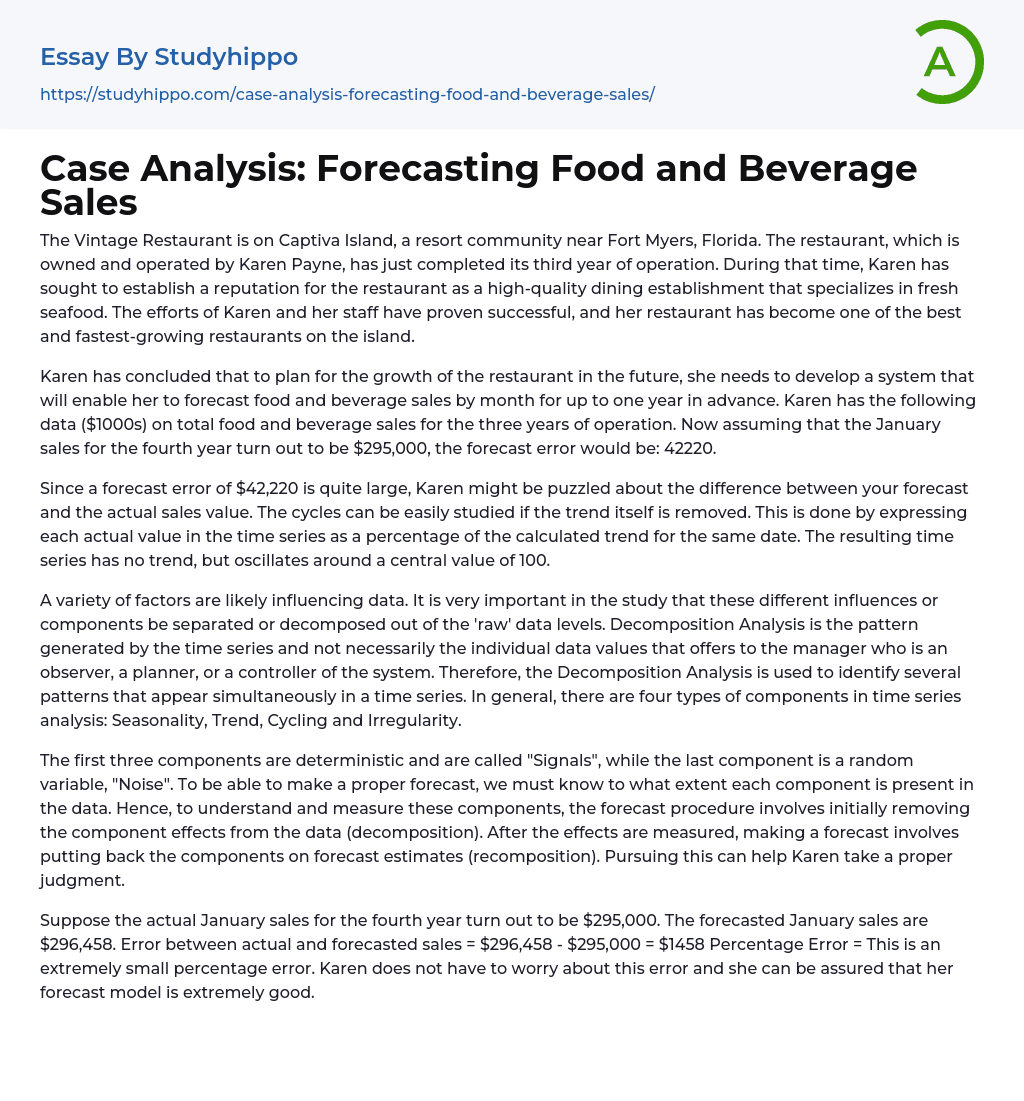

Case Analysis: Forecasting Food and Beverage Sales Essay Example
The Vintage Restaurant is on Captiva Island, a resort community near Fort Myers, Florida. The restaurant, which is owned and operated by Karen Payne, has just completed its third year of operation. During that time, Karen has sought to establish a reputation for the restaurant as a high-quality dining establishment that specializes in fresh seafood. The efforts of Karen and her staff have proven successful, and her restaurant has become one of the best and fastest-growing restaurants on the island.
Karen has concluded that to plan for the growth of the restaurant in the future, she needs to develop a system that will enable her to forecast food and beverage sales by month for up to one year in advance. Karen has the following data ($1000s) on total food and beverage sales for the three years of operation. Now
...assuming that the January sales for the fourth year turn out to be $295,000, the forecast error would be: 42220.
Since a forecast error of $42,220 is quite large, Karen might be puzzled about the difference between your forecast and the actual sales value. The cycles can be easily studied if the trend itself is removed. This is done by expressing each actual value in the time series as a percentage of the calculated trend for the same date. The resulting time series has no trend, but oscillates around a central value of 100.
A variety of factors are likely influencing data. It is very important in the study that these different influences or components be separated or decomposed out of the 'raw' data levels. Decomposition Analysis is the pattern generated by the time series and not necessarily the individual
data values that offers to the manager who is an observer, a planner, or a controller of the system. Therefore, the Decomposition Analysis is used to identify several patterns that appear simultaneously in a time series. In general, there are four types of components in time series analysis: Seasonality, Trend, Cycling and Irregularity.
The first three components are deterministic and are called "Signals", while the last component is a random variable, "Noise". To be able to make a proper forecast, we must know to what extent each component is present in the data. Hence, to understand and measure these components, the forecast procedure involves initially removing the component effects from the data (decomposition). After the effects are measured, making a forecast involves putting back the components on forecast estimates (recomposition). Pursuing this can help Karen take a proper judgment.
Suppose the actual January sales for the fourth year turn out to be $295,000. The forecasted January sales are $296,458. Error between actual and forecasted sales = $296,458 - $295,000 = $1458 Percentage Error = This is an extremely small percentage error. Karen does not have to worry about this error and she can be assured that her forecast model is extremely good.
- Food Safety essays
- Food Security essays
- Beverages essays
- Cuisines essays
- Dairy essays
- Desserts essays
- Fast Food essays
- Bread essays
- Meal essays
- Meat essays
- Organic Food essays
- Rice essays
- Sugar essays
- Taste essays
- Beef essays
- Coconut essays
- Crowd essays
- Dinner essays
- Juice essays
- Sainsbury essays
- Cooking essays
- Ginger essays
- Oreo essays
- Drink essays
- Beer essays
- Wine essays
- Coffee essays
- Tea essays
- Cake essays
- Hamburger essays
- Ice Cream essays
- Burger essays
- Pizza essays
- Fruit essays
- Lemon essays
- Food Waste essays
- Favorite Food essays
- Alcoholic essays
- Soft Drinks essays
- Cookie essays
- Starch essays
- Yeast essays
- Cola essays
- Pizza Hut essays
- snack foods essays
- chips essays
- Biscuit essays
- Brewing essays
- Brewery essays
- Fast Food Restaurant essays



